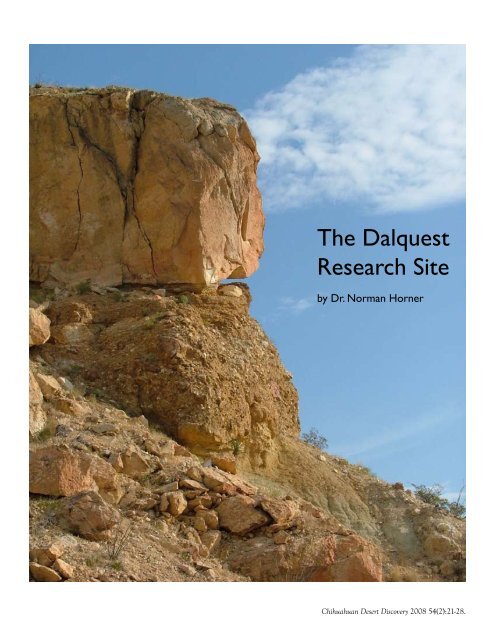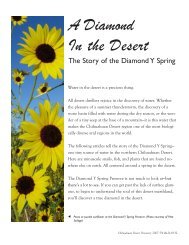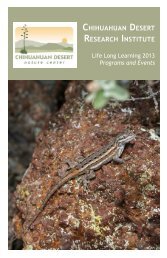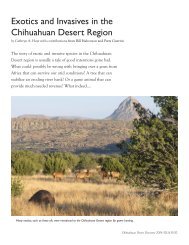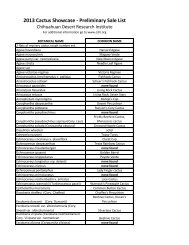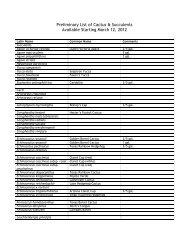The Dalquest Research Site - Chihuahuan Desert Nature Center
The Dalquest Research Site - Chihuahuan Desert Nature Center
The Dalquest Research Site - Chihuahuan Desert Nature Center
You also want an ePaper? Increase the reach of your titles
YUMPU automatically turns print PDFs into web optimized ePapers that Google loves.
<strong>The</strong> <strong>Dalquest</strong><br />
<strong>Research</strong> <strong>Site</strong><br />
by Dr. Norman Horner<br />
<strong>Chihuahuan</strong> <strong>Desert</strong> Discovery 2008 54(2):21-28.
Mitchell Mesa rhyolite.<br />
<strong>Chihuahuan</strong> <strong>Desert</strong> Discovery 2008 54(2):21-28.<br />
In August of 1968, I thought I was going to get to see the<br />
property in Brewster and Presidio counties that ultimately be-<br />
came known as the <strong>Dalquest</strong> <strong>Research</strong> <strong>Site</strong> (DRS), but as it<br />
turned out I had to wait another year to see this magnificent<br />
place. At that time, Dr. Walter W. <strong>Dalquest</strong> was 51 and a 16-year<br />
veteran teacher and researcher in the Department of Biology<br />
of what was then known as Midwestern University. I was completing<br />
my first year as a young instructor of Biology. <strong>Dalquest</strong><br />
was an energetic professor who knew what I thought was “most<br />
everything” about biology, and was a very productive research<br />
scholar.<br />
Dr. <strong>Dalquest</strong> knew I enjoyed field work and asked me to<br />
go with him to see the land (two sections) he had recently purchased<br />
south of Marfa. He bought it so he would have a place<br />
to hunt desert mule deer and enjoy the outdoors. After traveling<br />
for about 10 hours, we took a break approximately 15 miles<br />
from the property. <strong>Dalquest</strong> saw a bat flying and being the avid<br />
mammal collector, he immediately tried to shoot it so it could<br />
be added to the collection. In the process of following the bat,<br />
he stepped over a 30-inch Western Diamondback that nailed<br />
him on the inside of his left ankle. Well, our plans changed<br />
quickly, and I started a 3-hour drive to get him to the nearest<br />
hospital, which was in Alpine. My fun vacation turned into a<br />
week waiting for him to recover to a point where I could get him<br />
back to Wichita Falls. Since that failed first journey, I have had<br />
the privilege of visiting the site frequently over the last 40 years.<br />
<strong>The</strong> first 30 years were with Walt (Dr. <strong>Dalquest</strong>) and the last 10<br />
with students and colleagues from Midwestern State University<br />
(MSU).
In 1996 Dr. Walter W. <strong>Dalquest</strong> and<br />
his wife, Rose, donated the two sec-<br />
tions of land to MSU. <strong>The</strong>y knew the<br />
scientific value of the property and the<br />
need to preserve it for future generations<br />
of researchers. Deed restrictions<br />
limit the site to be used for scientific<br />
research. Dr. <strong>Dalquest</strong> lost his battle<br />
with Parkinson’s and passed away in<br />
September of 2000. A few years later<br />
Dr. <strong>Dalquest</strong>’s widow, Rose, provided<br />
funds to purchase an additional 2 2/3rd<br />
sections of adjacent land to bring the<br />
total to approximately 3,000 acres.<br />
Obviously Midwestern State University<br />
would not have this property if it was<br />
not for the generosity of the <strong>Dalquest</strong>s.<br />
It is difficult to describe the site in a<br />
manner so that you can comprehend<br />
its vastness, beauty, deep canyons,<br />
isolation, and ruggedness. This is a<br />
place where a satellite phone is the only<br />
means of outside communication, and<br />
your feet are the only reliable means of<br />
transportation. Currently no facilities<br />
are on the site and visitors must be<br />
primitive campers and carry an ample<br />
supply of water. Climatic changes can<br />
occur on short notice. <strong>The</strong> wind blows<br />
to the point of picking up small sand<br />
grains. <strong>The</strong> canyons can flood quickly<br />
and you can become trapped. Several<br />
years ago in March, I remember having<br />
a group of students on the site and we<br />
experienced snow, rain, hail, and sleet<br />
all in the same day! No individual can<br />
visit the site unless they are accompanied<br />
by at least one other person for safety.<br />
To a naturalist the DRS experience<br />
is a dream come true. <strong>The</strong> majority<br />
of the site has had little human influence;<br />
in fact, the property owner prior<br />
to Dr. <strong>Dalquest</strong> had fenced the canyon<br />
lands to keep cattle from getting into<br />
the area. Because it is an undisturbed<br />
area and is so isolated, two years ago<br />
a pair of nesting Golden Eagles were<br />
observed. <strong>The</strong>ir nest was constructed<br />
on a canyon ledge about 100 feet above<br />
the canyon floor and 60 feet below<br />
the canyon rim. It was a thrilling sight<br />
to watch the adults feed the nestlings.<br />
One afternoon while waiting for the<br />
return of the eagles, I thought about<br />
the silence we were experiencing. Essentially<br />
no man-made noises other than<br />
an occasional high altitude plane flying<br />
over. We routinely observed fresh kills<br />
of mule deer and collared peccary by<br />
cougars. Also on two occasions Zonetailed<br />
Hawks have been seen flying<br />
with a group of Turkey Vultures.<br />
Based on the time of the year and<br />
the amount of moisture, the desert<br />
<br />
Three-flowered living rock cactus (Ariocarpus fisseratus).<br />
will have plants blooming like Mexican<br />
buckeye, yucca, sotol, acacia, ocotillo,<br />
and a variety of cactus species.<br />
While absorbing all of the beauty<br />
and solitude, visitors must be aware<br />
of potential dangers. Rattlesnakes<br />
(western diamondback, Mexican blacktailed,<br />
mojave, and the rock rattler) are<br />
present, slipping and falling is always<br />
possible, and contending with extreme<br />
summer heat can be life-threatening.<br />
Common sense or good judgment for<br />
safety is essential.<br />
Mission Statement<br />
<strong>The</strong> <strong>Dalquest</strong> <strong>Research</strong> <strong>Site</strong>’s primary<br />
objective is to promote research and<br />
education about the <strong>Chihuahuan</strong> <strong>Desert</strong><br />
for undergraduates and graduate<br />
students. It is the intent of Midwestern<br />
State University to utilize the site to<br />
contribute to a better understanding<br />
<strong>Chihuahuan</strong> <strong>Desert</strong> Discovery 2008 54(2):21-28.
of the <strong>Chihuahuan</strong> <strong>Desert</strong> through<br />
biological and geological research and<br />
education. <strong>The</strong> site is owned and operated<br />
by Midwestern State University,<br />
but it is open to scientists from other<br />
universities pending approval of their<br />
research proposal.<br />
Geology of the <strong>Site</strong><br />
Dr. Christopher Kirk, Associate<br />
Professor of Anthropology at <strong>The</strong> University<br />
of Texas at Austin has collected<br />
fossils on the DRS for the past five<br />
years and gives the following account<br />
of the geology, which is based on the<br />
literature and his first hand experience<br />
of being on the site.<br />
<strong>The</strong> geological features of the DRS<br />
are highly varied and the topography is<br />
complex. <strong>The</strong> uplands in the western<br />
part of the site consist primarily of desert<br />
pediments overlying the early Oligocene<br />
Tascotal Mesa Formation and<br />
the 32 myo Mitchell Mesa welded tuff.<br />
Both features are the product of volcanic<br />
activity in the Chinati Mountains<br />
far to the west. <strong>The</strong> eastern part of the<br />
site includes extensive exposures of the<br />
late Eocene Devil’s Graveyard Formation<br />
approximately 200 m (650 ft) below<br />
a north-south tending escarpment.<br />
Water and wind have carved these<br />
tuffaceous sediments to produce a<br />
stunning landscape of deep red, white,<br />
and green “whalebacks” and steep-sided<br />
arroyos. <strong>The</strong> two forks of the Alamo de<br />
Cesario Creek run through the center<br />
of the property and have cut into the<br />
escarpment to produce a labyrinth of<br />
mesas, hoodoos, and deep canyons (see<br />
Nelson and Preston, 2006). <strong>The</strong> southern<br />
part of the DRS is transected by a<br />
<strong>Chihuahuan</strong> <strong>Desert</strong> Discovery 2008 54(2):21-28.<br />
<br />
Tascotal Mesa faultline that projects east-west across the property.<br />
major east-west tending faultline—the<br />
Tascotal Mesa Fault. South and west<br />
of this fault are outcrops of the Rawls<br />
Basalt, produced 28 mya by volcanic<br />
activity in the Bofecillos Mountains.<br />
Biodiversity Surveys at the DRS<br />
<strong>The</strong> majority of the preliminary biodiversity<br />
surveys that have been done<br />
or are currently underway are being<br />
conducted as masters’ theses by MSU<br />
biology students. In addition, Dr. Kirk<br />
and his students enrolled in paleontology/anthropology<br />
field camps at the<br />
DRS have found several interesting and<br />
evolutionary important fossils. <strong>The</strong>y<br />
have been collecting vertebrate fossils<br />
from the Devil’s Graveyard Formation.
<strong>Chihuahuan</strong> <strong>Desert</strong> Discovery 2008 54(2):21-28.
<strong>The</strong>se collecting trips have yielded<br />
one of the best preserved Late Uintan<br />
Faunas known from North America<br />
(Kirk and Williams, 2009). Descriptions<br />
of new primate species in two<br />
genera, a new primate genus (Williams<br />
and Kirk, 2008) and a new genus of<br />
amphisbaenian (reptile) are currently<br />
being described (Kirk, in prep.).<br />
Based on initial surveys of the invertebrate<br />
fauna, several species are new<br />
to science. A preliminary survey of the<br />
ground-dwelling spiders at DRS using<br />
pitfall traps yielded 1326 specimens.<br />
<strong>The</strong>y were collected from two habitattypes,<br />
one being typical desert pavement/shrubland<br />
and the other in the<br />
floodplain of Alamo de Cesario Creek.<br />
<strong>The</strong> specimens included 66 species<br />
distributed in 46 genera and 24 families<br />
(Broussard, 2002; Broussard and<br />
Horner, 2006). Several species are new<br />
to science (Platnick and Horner, 2007)<br />
and one is likely a new family to science.<br />
<strong>The</strong>se specimens are currently being<br />
evaluated by Dr. Norman Platnick<br />
and his staff at the American Museum<br />
of Natural History. <strong>The</strong>y appear to<br />
belong to a new family or at least one<br />
not known from the new world.<br />
Killion’s (2005) 26-month floral<br />
survey of a 10,000 m2 plot yielded 68<br />
identified species from 29 families,<br />
with the exclusion of the grasses. <strong>The</strong><br />
<strong>Chihuahuan</strong> <strong>Desert</strong> indicator species<br />
of lechuguilla, creosote bush, and tarbush<br />
were abundant.<br />
<br />
<strong>The</strong> Devil’s Graveyard Formation is<br />
composed of multicolored tuffaceous<br />
mudstones.<br />
<strong>Chihuahuan</strong> <strong>Desert</strong> Discovery 2008 54(2):21-28.<br />
<br />
Flame skimmer dragonfly (Photograph by James Lasswell).<br />
To date, 84 species of birds have<br />
been sighted (Holbert, in progress)<br />
including: Common Raven, Turkey<br />
Vulture, four species of wrens, Golden<br />
Eagle, Spotted Towhee, Doves (Whitewinged<br />
and Mourning), Scott’s Oriole,<br />
Say’s Phoebe, Black-throated Sparrow,<br />
Western Kingbird, and Northern Waterthrush.<br />
Common native mammals seen or<br />
identified by tracks include Merriam’s<br />
kangaroo rats, hispid pocket mouse,<br />
cactus mouse, desert cottontail, blacktailed<br />
jackrabbit, collared peccary, mule<br />
deer, kit fox, coyote, bobcat, mountain<br />
lion, and squirrels (rock and Texas<br />
antelope ground squirrel). Introduced<br />
species include the aoudad sheep which<br />
have an established population and the<br />
feral asses are occasional visitors.<br />
A total of 994 cursorial coleopterans<br />
were collected at the site using pitfall<br />
trapping from three habitat-types<br />
(Middleton et al, 2007). This sample<br />
included 53 species from these three<br />
taxa, Carabidae, Scarabaeoidea, and<br />
Tenebrionoidea.<br />
During two 12-month surveys for<br />
aquatic insects from Alamo Spring and<br />
a freshwater pool, Hamilton (2000)<br />
and Weger (in progress) have produced<br />
more that 40 genera in 31 families and<br />
6 orders. Weger appears to have at least<br />
one new species of aquatic beetle. In<br />
addition to the above organized studies,<br />
a preliminary butterfly list has 25 species.<br />
We’ve also documented 6 species<br />
of dragonflies and 14 species of herps.<br />
Future Development<br />
When funding can be obtained, the<br />
Biology Department at MSU intends<br />
to construct a Field Station on the site.<br />
At this point the name will be changed<br />
from the <strong>Dalquest</strong> <strong>Research</strong> <strong>Site</strong> to<br />
the <strong>Dalquest</strong> <strong>Research</strong> Station. MSU<br />
will seek the participation of ecologists<br />
from other universities, and it is our
intent to cooperate with the Long<br />
Term Ecological <strong>Research</strong> (LTER) Programs<br />
in the Southwest.<br />
<strong>The</strong> establishment and development<br />
of the DRS will provide the first<br />
scientific, academic station devoted<br />
exclusively to research and training<br />
in research methods in the Big Bend<br />
region. It will also provide the most<br />
southeastern node of a network of permanent<br />
<strong>Chihuahuan</strong> <strong>Desert</strong> research<br />
stations ranging 750 km at 200 to 250<br />
km intervals from Sevilleta LTER near<br />
Socorro, NM in the north, to Jornada<br />
Basin LTER north of Las Cruces, NM,<br />
and then to Indio Mountains <strong>Research</strong><br />
Station, southwest of Van Horn, TX,<br />
which is about 200 km from DRS. <strong>The</strong><br />
closest field station to DRS is the Indio<br />
Mountains <strong>Research</strong> Station, which is<br />
operated by the University of Texas at<br />
El Paso (Johnson, 2004). However, the<br />
geologies of the two sites differ, with<br />
the Indio Mountains site composed of<br />
Late Cretaceous sedimentary rocks.<br />
MSU is committed to a site that conserves<br />
both energy and materials as well<br />
as the native environment of DRS. A<br />
preliminary goal is to NOT bring electric<br />
service to the Station and to refrain<br />
from air-conditioning the structures.<br />
<strong>The</strong> goal is to build structures that do<br />
not disrupt the environment nor the<br />
native biota. Plans are to build a main<br />
structure of either mud or earthen<br />
walls, which will provide insulation<br />
and that is powered by renewable solar<br />
and/or wind power. Cooling will be<br />
passive and involve insulation, window<br />
placement, size, orientation, and shuttering<br />
as well as thermal towers. We are<br />
anticipating employing waterless toilets,<br />
specimen driers that use passive heating<br />
and air flow to dry specimens effectively<br />
without damage, rainwater capture<br />
in stainless steel cisterns, wind-driven<br />
pumps for the water well(s), and passive<br />
orientation of the main building that<br />
makes use of wind-cooling, and wastewater<br />
capture. In short, the buildings<br />
and facilities must be energy efficient.<br />
We are cognizant of the potential for<br />
visiting scientists to introduce, inadvertently,<br />
alien species and for the struc<br />
<strong>Chihuahuan</strong> <strong>Desert</strong> Discovery 2008 54(2):21-28.
tures to attract non-native fauna.<br />
Policies that might inhibit both these<br />
possibilities are being developed.<br />
In order for this to be a functional research<br />
facility, the infrastructure clearly<br />
needs to include: laboratories; dormitories;<br />
a kitchen; storage for equipment;<br />
fencing to maintain the natural integrity<br />
of the site; and telecommunications<br />
and computer systems for the exchange,<br />
storage, and interpretation of data and<br />
for visiting scientists to maintain contact<br />
with their labs, students, and other<br />
scientists. However, MSU seeks input<br />
from the community of field biologists<br />
and geologists to provide optimal facilities<br />
and programs.<br />
Acknowledgements<br />
Appreciation is expressed to Dr.<br />
James Estes, Emeritus Professor of<br />
Botany, University of Oklahoma; Dr.<br />
William Cook, Chair of the Biology<br />
Department, MSU; Dr. Pamela Stephens,<br />
Chair of Geosciences, MSU;<br />
and Dr. Christopher Kirk, Professor<br />
of Anthropology, University of Texas<br />
at Austin. Each of these individuals<br />
assisted in the preparation of a funding<br />
grant. Some of the information in<br />
this article came from the submitted<br />
document.<br />
<br />
<br />
Drainage from Alamo Spring just above<br />
the Tascotal Mesa faultline.<br />
Eocene mudstones and sandstones photographed<br />
from the canyon floor.<br />
<strong>Chihuahuan</strong> <strong>Desert</strong> Discovery 2008 54(2):21-28.<br />
References<br />
Broussard, G.H., & N.V. Horner 2006.<br />
Cursorial spiders (Araneae) in the <strong>Chihuahuan</strong><br />
<strong>Desert</strong> of west Texas. Entomological<br />
News 117(3): 249–260.<br />
Broussard, G.H. 2002. A pitfall trap survey<br />
of cursorial spiders (Araneae) from two<br />
microhabitats in the <strong>Chihuahuan</strong> <strong>Desert</strong><br />
of west Texas. Master’s thesis: Midwestern<br />
State University.<br />
Hamilton, D.E. 2000. A limnological<br />
comparison of two freshwater springs in<br />
the <strong>Chihuahuan</strong> <strong>Desert</strong>. Master’s thesis:<br />
Midwestern State University.<br />
Holbert, D. (In Progress). A survey of the<br />
avifauna of the <strong>Dalquest</strong> <strong>Research</strong> <strong>Site</strong> in<br />
the <strong>Chihuahuan</strong> <strong>Desert</strong> of west Texas. Master’s<br />
thesis: Midwestern State University.<br />
Killion, K. 2005. A floral survey at base camp<br />
of a <strong>Chihuahuan</strong> <strong>Desert</strong> research site in<br />
Brewster County, Texas. Master’s thesis:<br />
Midwestern State University.<br />
Kirk, E.C., & B.A. Williams. 2009. Phylogenetic<br />
relationships of late Uintan primates<br />
from the Devil’s Graveyard Formation,<br />
Texas. American Journal of Physical Anthropology<br />
S48:1–166.<br />
Middleton, S.M., G.H. Broussard, M.H.<br />
Shipley, & R.C. Vogtsberger. 2007. Inventory<br />
of three beetle species assemblages<br />
(Coleoptera: Carabidae, Scarabaeoidea,<br />
Tenebrionoidea) from the <strong>Chihuahuan</strong><br />
<strong>Desert</strong> of west Texas. Texas Journal of Science,<br />
59 (1):39–50.<br />
Middleton, S.M. 2003. An ecological assessment<br />
of three families of Coleoptera<br />
from the <strong>Chihuahuan</strong> <strong>Desert</strong> of west Texas.<br />
Master’s thesis: Midwestern State University.<br />
Nelson, W. W., & D. Preston. 2006. Ribbons<br />
of Time: <strong>The</strong> <strong>Dalquest</strong> <strong>Research</strong> <strong>Site</strong>.<br />
Midwestern State University Press: Wichita<br />
Falls, TX.<br />
Platnick, N.I., & N. Horner. 2007. A new<br />
species of Drassyllus (Araneae, Gnaphosidae)<br />
from west Texas. Journal of Arachnology<br />
35:197–198.<br />
Sink, R.L. 2003. Prokaryotic microbial<br />
community profiling of a <strong>Chihuahuan</strong><br />
<strong>Desert</strong> spring using denaturing gradient gel<br />
electrophoresis. Master’s thesis: Midwestern<br />
State University.<br />
Weger, J. (In Progress). A survey of the<br />
aquatic insects of Alamo Springs in the<br />
<strong>Chihuahuan</strong> <strong>Desert</strong> of west Texas. Master’s<br />
thesis: Midwestern State University.<br />
Williams, B.A., & E.C. Kirk. 2008. New<br />
Uintan primates from Texas and their implications<br />
for North American patterns of<br />
species richness during the Eocene. Journal<br />
of Human Evolution 55:927–941.


